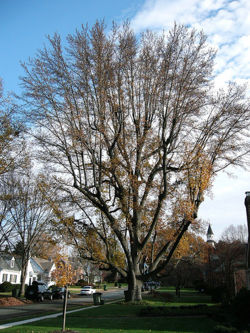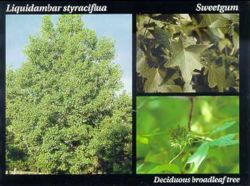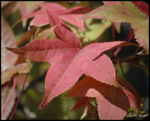Sweetgum
| Sweetgum |
|---|

|
| Scientific Classification |
|
| Species |
|
Sweetgum is a large shade tree that reaches up to 25-40 meters. It is a common hardwood with a good quality that is used for interior and furniture manufacturing. They looks very similar to maples, since the leaves are 5 pointed lobes and the leaves change their colors to red during the fall. They are called the 'sweetgum' because pioneers in the early age chewed the bark of the sweetgum tree as a gum. The sweetgum is also known as a living fossil. One of the oldest species have lived during more than 55,000,000 years ago. Twenty species are extinct and four species are known to be existing.
Characteristics
Sweetgum is a large tree that reaches 25-40m in height.[1] The leaves are star-shaped with 5 to 7 sharp pointed lobes. Each leaf is a shiny dark green on top and gets paler underneath the leaves. The deciduous leaves turn red, orange, yellow, and purple in autumn. The fruit is a round head of two-celled capsules. Fruits mature in autumn and are attached to the tree throughout the winter. When it is time for them to fall, they become spiny balls. The bark of the sweetgum tree is deeply wrinkled and gray. The bark gets a wrinkled appearance after the second year. [2]
Seed production
Trees start to produce seeds when they are 20 to 30 years old and keep on producing until they are at least 150 years of age. Seed production differs widely according to the climatic conditions during the growing season. Under appropriate condition, 56 seeds as a maximum and 7 or 8 seeds as a minimum can be in seed balls. According to the Forestry Sciences Laboratory, a group which has collected seed balls for more than 12 years, 20 to 30 seeds are most likely to be found in the seed balls. When the drought in the summer is extended, and the moisture of soil dries out, low percentage of seeds tends to come out of seed balls. Only 5 seeds might come out of seed balls in the worst condition. The seeds can be dispersed about to 183 m (600 ft), but usually 96 percent of the seed falls within 61m (200 ft) of the tree. The seed soundness of sweetgum varies widely. In a good seed year, seed soundness may reach 80 to 90 percent, but it may drop to 10 to 20 percent during the bad seed year. [3]
Uses
The sweetgum contributes to the production of hardwoods. This hardwood is usually used for furniture, flooring, veneers, home interiors, and other lumber application. The wood is also used as paper pulp to make papers and to make baskets. The bark of sweetgum tree was once used as chewing gum by pioneers. This is how the name of this tree originated. Sweetgum tree is also helpful tree in the hot region, since this tree makes a good shade to rest on. [4] Gum, the product of the sweetgum tree, is very useful. It is also used in herbal medicine. Additionally, this fruit contains a small amount of aromatic hydrocarbon styrene. The extract of this gum helped the discovery of polymer polystyrene. [5]
History
The sweetgum is a living fossil. Twenty species are known to be extinct, and we now know there are four species: one in central and southern China, one in Formosa, one in Turkey, and one native to America. The oldest species is known to be on earth more than 55,000,000 years ago.[6] Many species disappeared in Europe due to extensive glaciations in the Alps and the north. Same thing happened in western North America due to climate change, additionally, some also disappeared in Russian Far East due to the unglaciation.[7]
Gallary
Related References
- Sweetgum by multiple authors. Wikipedia.
- Sweetgum University of Florida.
- The City Naturalist - Sweet Gum Tree by Leslie Day. NY Site.
- Sweetgum by Paul P. Kormanik. USDA.






